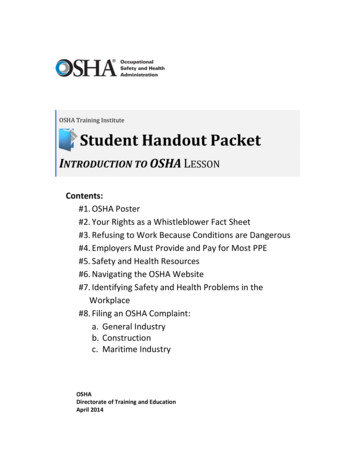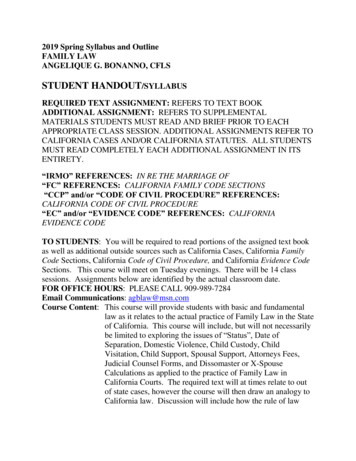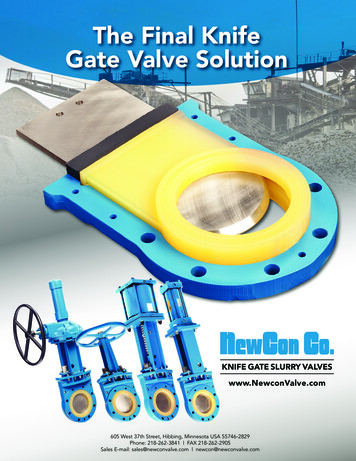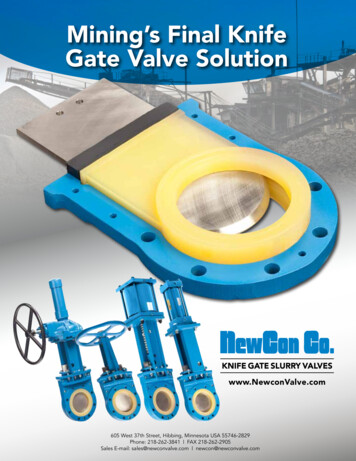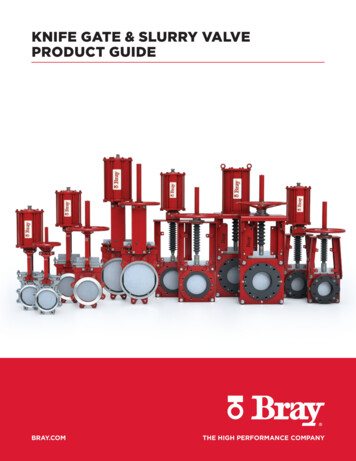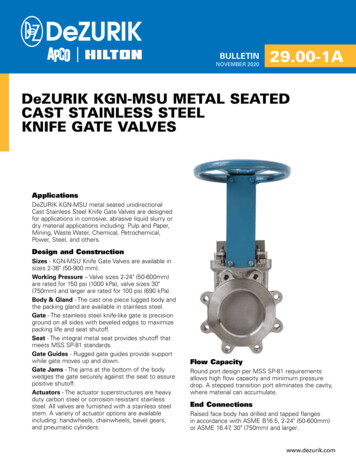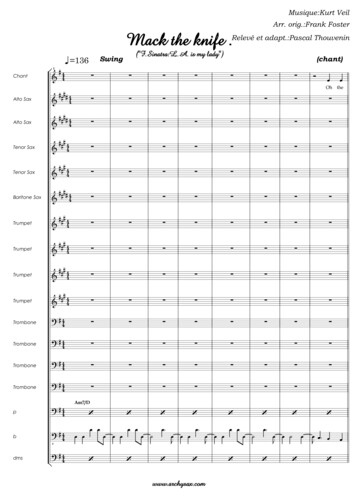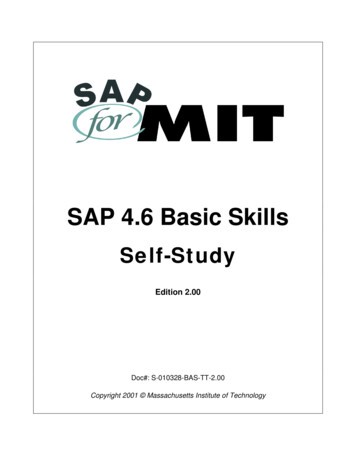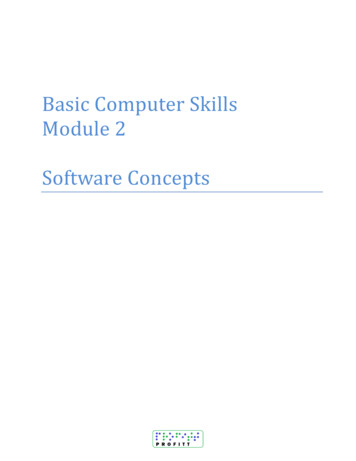
Transcription
Basic Knife SkillsStudent Handoutvikingrange.com1 Viking Range Corporation
Basic Knife Skills - IntroductionNo other kitchen tool is more important than the knife. The only piece of "equipment" morebasic to cooking is the human hand. Good quality knives will make your work easier, moreefficient, and more enjoyable; furthermore, good knives, when properly cared for, will last alifetime. Knives should be selected, sharpened, cleaned and handled with great care and respect.Safety Keep your blades sharp!Only cut on appropriate surfaces, never on metal, glass, or hard stone such as marbleor granite.Never attempt to catch a falling knife.Use the right knife for the task at hand.Never use a knife for any purpose other than what it was intended – e.g., never useyour knife to open a can or pry something loose.Do not leave your knives in a sink full of water.Pass a knife by its handle.Always cut away from yourself; never cut towards yourself.Learn and use the proper grip for your knife.Keep fingers on guiding hand curled.When walking with a knife, hold it closely to your side with the tip-end down and theblade facing away from you.Knife Nomenclature Tip or Point – The tip end of the blade may vary in shape, depending on the type and styleof the knife. The most common shapes are a point or a rounded end.Back or Spine – The thicker, unsharpened edge of the blade.Cutting Edge – The sharpened edge of the blade. The edge may be one of several types:plain, with a cross section revealing a gentle taper to a long or abrupt V-shape; hollowground with a distinct concave area running down the length of each blade side; granton,with elongated ovals ground into the flat side of the blade perpendicularly to the cuttingedge and staggered alternately on each blade side; and serrated edges, which end as a seriesof tiny, V-shaped teeth.Heel – The rear edge of the blade that extends below the bottom line of the handle.Bolster or Shoulder – The thick band of steel on forged blades that runs perpendicularacross the blade from the heel to the spine.Tang – The unsharpened rear extension of the blade that extends into the handle. Tangs maybe full, partial or rattail. (See Knife Selection / Construction for definitions)Handle – The handgrip that is typically covered with metal, plastic, wood or bone applied ineither one or two pieces. Occasionally, it is simply an extension of the blade steel, like thoseon some Asian-style knives and Chinese cleavers. It more often appears as a stylizedrectangle, tube, bulb or knob with a smooth, ribbed, or textured finish.Rivets – The metal studs that attach the handle to the tang of the knife.Butt – The rear end of the handle.vikingrange.com2 Viking Range Corporation
Anatomy of a KnifeTIP or POINTBACK or SPINECUTTING EDGEHEELBOLSTER orSHOULDERHANDLERIVETSTANG (not shown)Runs from thebolster to the buttinside the handleBUTTvikingrange.com3 Viking Range Corporation
Knife SelectionWhen selecting a knife, consider the composition, construction, comfort, and the job for whichthe knife will be used.Composition – What is the blade made of? Carbon Steel takes and holds the sharpest edge; however it discolors, pits easily, and caninteract with acidic foods. Stainless Steel stays clean and is non-reactive; this material is so hard that it is very difficultto sharpen and the blade dulls easily. High-Carbon Stainless offers the best of both materials; it has enough carbon steel to takeand hold a sharp edge plus all the virtues of stainless. It is considered by many to be the bestoverall choice.Construction – How is the knife made? Stamped Blades – Created by feeding long, fairly thin sheets of steel through a press thatstamps out the blades. They are then tempered (heated and cooled repeatedly) to strengthenthe steel, sharpened and finished. Because machines perform most of the work, these bladestend to be less expensive. They also tend to be lighter in weight than a fully forged blade. Astamped blade is thin with even thickness from handle to tip. Forged Blades – Created by heating a piece of steel to above 2,000 F, then placing it into amold and hammering to refine its shape. Excess metal is ground away, then the blade istempered, sharpened and finished, a process that can take as many as 100 steps. A forgedblade is thinner at the tip of the blade and thicker at the handle with a telltale band of steelknown as the bolster or shoulder. These blades tend to be heavier than stamped blades.Because of the high craftsmanship and the labor-intensive construction, these knives tend tobe more expensive and are highly regarded by many as superior to stamped blades. Full Tang – The unsharpened rear extension of the blade onto which the handle is attachedis known as the tang. A full tang runs the entire length of the handle with a shape to match.Full tang knives tend to be heavier and more evenly balanced than those with lesser tangs. Half or Three-Quarter Tang – While shaped like the knife, the tang extends only partiallyinto the handle. Rattail Tang – Runs like a rod down the length of the handle.Types of KnivesIt’s important to use the right knife for the right job. There are many specialized knives, but themajority of daily kitchen tasks may be accomplished with a few good, basic knives.Must-Haves: Chef’s Knife (also called French orCook’s Knife) Paring Knife Serrated Knifevikingrange.comNice-to Haves: Santoku or hollow-ground chef’s knife Utility Knife, 6-inch Bird’s Beak or Tourné Knife Slicing/Carving Knife, 12-inch Boning Knife Flexible Boning Knife (for chicken orfish fillets or a rigid one for meat) Cleaver4 Viking Range Corporation
Chef’s Knife (French Knife or Cook’s Knife): Typically 8 to14-inches long, this allpurpose knife used for chopping, slicing and mincing is the workhorse of the kitchen. Thetapered blade curves up at the tip to facilitate its ability to be used with a rocking motion forchopping and mincing. These knifes are purposely fairly heavy, as their weight assists withchopping and mincing tasks.Hollow-ground Chef’s Knife: Typically 8-inches in length, this knife combines the classictapered blade of the chef’s knife with the hollow-ground blade design of the santoku and themeat slicer. Considered by many to be the best of both worlds, the shape of the bladefacilitates its ability to be used with a rocking motion for chopping and mincing, while thehollow-ground feature reduces drag when cutting and slicing delicate fish, meats, fruits orvegetablesSantoku: Compared with a classic chef’s knife, the santoku is typically shorter and has athinner blade, a stubbier tip, and a straighter edge. It is thought to have evolved from thenarrow, rectangular Japanese vegetable knife and may be called an Asian chef’s knife. Itmay have a smooth or a granton blade (hollow-ground with oval recesses along the blade).The thinness of the blade makes it an excellent choice for delicate or precise knife work,most notably for slicing. Because it does not have as curved a tip as the French or chef’sknife, it does not rock as easily for standard chopping and mincing.Utility Knife: Typically 5 to 7-inches long, it is a smaller, lighter version of the chef’s knife.It may be used as a chef’s knife on smaller items or as a paring knife on larger items.Paring Knife: Typically 3 to 4-inches long, a paring knife looks very much like a chef‘sknife, but is considerably smaller. Structurally, because the parer is not an impact tool, thecurve of a paring knife blade is usually not as pronounced as that of most chef’s knives.Instead, a paring knife works more as an extension of your hand and is used for paring andtrimming fruits and vegetables.Bird’s Beak or Tourné: Typically 2 to 4-inches long, this small knife is similar to a paringknife, but with a pronounced forward curve in the blade at the tip. Used to peel vegetablesand carve rounded surfaces on vegetables (such as tourné vegetables).Boning Knife: Approximately 6-inches long, its stiff, thin blade is used to separate rawmeat from the bone. It typically has a pronounced heel that helps to stop the knife at thehandle when it is thrust into firm meat.Fillet Knife: Approximately 6-inches long with a flexible blade, it is used for filleting fowland fish. Its flexibility allows it to move smoothly over delicate bones that would be cut by afirm boning knife.Slicer or Carving Knife: Typically 10 to 16-inches long, it is used for slicing cookedmeats. The long blade may be wide or narrow, flexible or rigid, have a rounded or pointedtip, and have a smooth or modulated surface. The heavier, hard-bladed slicers are designedto cut broader slices through hot, softer meats. If the surface of the meat is firm andrelatively dry (as in cold roast or a ham), the meat is less resistant, and the thinner, narrowerblades are suitable.Cleaver: Comes in various sizes with a rectangular blade, it is usually heavy and istraditionally used for chopping through bones and large pieces of meat.vikingrange.com5 Viking Range Corporation
Serrated Knife: Typically 8 to 12-inches long, it is also referred to as a bread knife, as theserrated blade is perfect for cutting breads, pastries, tomatoes or other soft foods. It is also anexcellent choice for large, very hard vegetables such as butternut squash. The combinationof the serrated teeth used with a sawing motion allows you to break through the hard skinwithout as much pressure or force as would be required with a non-serrated blade, andconsequently is much safer.Use and Care of Cutlery Always clean your knife thoroughly after each use so that it will not become a site for foodcross-contamination.It is not recommended to put your knives in the dishwasher. Wash them carefully by handwith warm soapy water, then dry them and put them away.Store your knives properly. If they are to be stored in a drawer, they should be sheathed toprotect their edge and to reduce the danger of being cut by the exposed blade. Alternatively,knives may be stored on a magnetic knife rack (make sure the magnets are strong enough tohold your heaviest knives), in a knife block or knife roll. Be sure to always store knivesclean and to their keep storage compartments clean.Do not hold knives in a flame or dip them into a pot of hot food.Do not use knives to pry up jar lids or for any other unintended uses.Use the right knife for the task; do not use a lightweight tool for a heavy-duty task.Sharpening KnivesA sharp knife is a safe knife, as well as a pleasure to use. There are basically two types ofsharpeners; those that straighten or realign the edge and those that grind and reshape or “set” theedge. If you were to look at a knife under a microscope, you would see that it is made up ofthousands of small cutting teeth. Through use, these teeth become misaligned. Using a steel willeffectively realign these teeth. After prolonged use, however, the edge will need to be reground.This requires shaving small bits of metal from the edge to reshape it. The reshaping requires thatthe blade be ground at very precise angles; the most durable edges are created using two or threeangles in a single edge. You may take your knife to a professional to have the edge reground, oryou may use a stone to sharpen it yourself. Achieving perfect angles using a stone requires agreat deal of practice and expertise. Another option is to use an electric knife sharpener that haspreset angles to allow you to sharpen and hone the knife at the correct angle. These require muchless skill than using a stone and are very reliable when used according to the manufacturer’sinstructions. Additionally, unlike a stone, which produces a single-angled edge, electricsharpeners typically produce strong, durable two and three-angle edges, so the knife remainssharper for a longer period of time.vikingrange.com6 Viking Range Corporation
Using a Sharpening Stone:A knife blade is sharpened by passing its edge over a rectangular abrasive stone. The grit (thedegree of the coarseness or fineness of the stone) wears away the blade's edge producing a sharpcutting edge. The angle of the knife to the stone must be very precise to produce a proper edge.Most stones may be used either dry or moistened with water or oil. If you choose to wet thestone, always use the same type of liquid (either oil or water) to moisten it. If you use oil, itshould be mineral oil, not a cooking oil such as vegetable, olive, or canola oil. Before using astone, make sure the stone is secure. Place the stone on a dampened cloth to stabilize it. Hold theblade at a 20 degree angle to the surface of the stone and draw the full length of the blade acrossthe stone. Apply light even pressure. Repeat these strokes the same number of times on each sideof the blade. Wipe the blade free of any particles before changing to a different degree of stoneor before honing on a steel.Using an Electric Sharpener:Most electric sharpeners have several slots, each of which is designed to grind the knife edge at adifferent angle. In the first stage of grinding, sometimes called pre-sharpening, the knife isplaced in a slot that removes the dull edge and creates the first bevel, or angle, of the two thattogether make up the knife’s edge. This first angle (called the relief angle) is typically aroundfifteen degrees to the face of the blade. The knife is then moved to a different slot, which makesa slightly more sloped bevel (the sharpening angle) that comes to the point of the edge. Theresult is a double-beveled edge, which is very strong, very durable, and will resist dulling. Somesharpeners cut a third bevel for an even stronger edge.Using a Sharpening Steel:A steel, a long round or oval rod with a handle, must be harder than the material from which theknife is made. Consult your knife manufacturer for recommendations on an appropriate modelfor your knives. A steel should be used both immediately after sharpening the blade on a stoneand also b
Paring Knife: Typically 3 to 4-inches long, a paring knife looks very much like a chef‘s knife, but is considerably smaller. Structurally, because the parer is not an impact tool, the curve of a paring knife blade is usually not as pronounced as that of most chef’s knives. Instead, a paring knife works more as an extension of your hand and is used for paring and trimming fruits and .File Size: 435KBPage Count: 9
